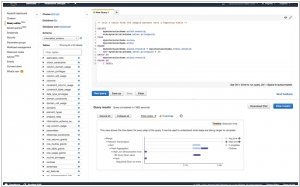Amazon Redshift vs Apache Hive
May 18, 2023 | Author: Michael Stromann
12

Amazon Redshift is a fast, fully managed, petabyte-scale data warehouse service that makes it simple and cost-effective to efficiently analyze all your data using your existing business intelligence tools. You can start small for just $0.25 per hour with no commitments or upfront costs and scale to a petabyte or more for $1,000 per terabyte per year, less than a tenth of most other data warehousing solutions.
13

The Apache Hive data warehouse software facilitates querying and managing large datasets residing in distributed storage. Hive provides a mechanism to project structure onto this data and query the data using a SQL-like language called HiveQL. At the same time this language also allows traditional map/reduce programmers to plug in their custom mappers and reducers when it is inconvenient or inefficient to express this logic in HiveQL.
Amazon Redshift and Apache Hive are both widely used for processing and analyzing large datasets, but they differ in several key aspects, including architecture, query language, and performance optimizations.
One significant difference is their underlying architecture. Amazon Redshift is a columnar storage-based data warehousing solution specifically designed for fast analytical queries. It utilizes a massively parallel processing (MPP) architecture to distribute data and processing across multiple nodes, resulting in high performance for complex queries. On the other hand, Apache Hive is built on top of Apache Hadoop and utilizes a distributed processing framework called MapReduce. Hive stores data in a distributed file system, such as Hadoop Distributed File System (HDFS), and enables SQL-like querying through its query language HiveQL.
Another difference lies in their query languages. Amazon Redshift uses a modified version of PostgreSQL SQL, which is optimized for columnar storage and provides rich analytic functions. It also supports user-defined functions (UDFs) and procedural languages like Python and R for advanced analytics. Apache Hive, on the other hand, uses HiveQL, which is a SQL-like query language that translates queries into MapReduce jobs for distributed processing. HiveQL is similar to SQL but may have slight variations and limitations compared to traditional SQL.
In terms of performance optimizations, Amazon Redshift employs various techniques such as column compression, zone maps, and parallel processing to deliver high query performance. It also offers features like sort keys and distribution styles to optimize data storage and retrieval. Apache Hive, while scalable and suitable for processing large datasets, may have longer query execution times due to the overhead of translating queries into MapReduce jobs.
Furthermore, Amazon Redshift is a fully managed service provided by Amazon Web Services (AWS), which handles infrastructure management, scaling, and backups. In contrast, Apache Hive requires manual setup and configuration, often running on a Hadoop cluster.
See also: Top 10 Big Data platforms
One significant difference is their underlying architecture. Amazon Redshift is a columnar storage-based data warehousing solution specifically designed for fast analytical queries. It utilizes a massively parallel processing (MPP) architecture to distribute data and processing across multiple nodes, resulting in high performance for complex queries. On the other hand, Apache Hive is built on top of Apache Hadoop and utilizes a distributed processing framework called MapReduce. Hive stores data in a distributed file system, such as Hadoop Distributed File System (HDFS), and enables SQL-like querying through its query language HiveQL.
Another difference lies in their query languages. Amazon Redshift uses a modified version of PostgreSQL SQL, which is optimized for columnar storage and provides rich analytic functions. It also supports user-defined functions (UDFs) and procedural languages like Python and R for advanced analytics. Apache Hive, on the other hand, uses HiveQL, which is a SQL-like query language that translates queries into MapReduce jobs for distributed processing. HiveQL is similar to SQL but may have slight variations and limitations compared to traditional SQL.
In terms of performance optimizations, Amazon Redshift employs various techniques such as column compression, zone maps, and parallel processing to deliver high query performance. It also offers features like sort keys and distribution styles to optimize data storage and retrieval. Apache Hive, while scalable and suitable for processing large datasets, may have longer query execution times due to the overhead of translating queries into MapReduce jobs.
Furthermore, Amazon Redshift is a fully managed service provided by Amazon Web Services (AWS), which handles infrastructure management, scaling, and backups. In contrast, Apache Hive requires manual setup and configuration, often running on a Hadoop cluster.
See also: Top 10 Big Data platforms


